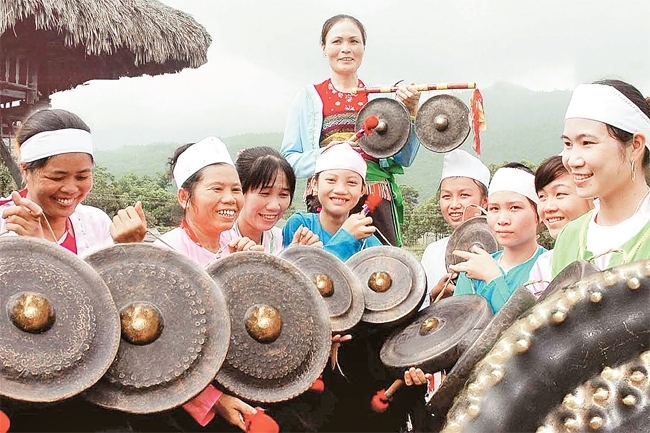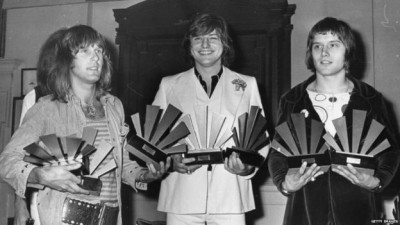Ba Vi is a mountainous district in Hanoi, home to the Muong, Dao and Kinh ethnic minority groups along with customs imbued with unique local cultural identities. Gong art of the Muong ethnic minority group is a traditional cultural art form, creating a unique attraction for the district.
A ‘golden age’

Reminiscing of days past when she joining gong ensembles to give performances and attend national arts festivals, artisan Dinh Thi Lan, who is now nearly 80 years old and deputy head of the Ba Trai commune gong ensemble, happily recalled achievements, such as receiving a Certificate of Merit from the Ministry of Culture and Information at the 1987 Gong Music and Culture Festival in Thanh Hoa.
Although Lan has had a passion for gongs since she was very young, she as well as many local people have never known when this art form first appeared.
They were only ever told that the first Muong people who migrated from Hoa Binh to Ba Vi mountain brought and used gongs in festivals, new year occasions, weddings and funerals.
Due to the mountainous terrain, the sound of the traditional instrument is a powerful medium of communication for local people.
Therefore, through the different tones of the gongs’ sound, Muong people can know what is happening in the village and when to gather.
The sound of gongs celebrating the Lunar New Year’s Eve have an animated, pulsating and cheerful rhythm; meanwhile the jubilant sounds to open festivals seem to urge people to join the festive activities.
Girls and boys also use gongs to declare their love on moonlit nights; or gongs on wedding days are considered as wishes of happiness for the newlywed couples.
Gongs are attached to all activities of Muong ethnic people, becoming a traditional cultural characteristic which has been handed down from generation to generation.
The villagers have considered gongs as family heirlooms, so all families own at least one gong.
The gongs of Muong people in Ba Vi are different from those in the Central Highlands, featuring knobs in the middle and carry ropes.
Notably, in Muong ethnic groups, only women, wearing traditional costumes, are allowed to beat gongs. Each woman carries a gong and beats it with a stick.
For people in the Central Highlands region, gongs are means for them to communicate with the gods, while Muong ethnic people in Ba Vi use gongs as a musical instrument in their daily lives.
Sadly, gongs have been absent in Muong people’s lives for a long time. Dinh Ngoc Dan (70) in Lat village, Minh Quang commune said that in the past, each family in the commune had at least one gong; however due to the devastation of wars and hunger, some households had to sell their gongs, while many villagers used them as covers of the soy sauce and salt vessels.
In addition, many individuals took advantage of people’s trust and called themselves ‘folk culture officials’ to borrow, change, and even seize original gongs, selling them to antique dealers.
By the early 2000s, officials from the Ethnic Minority Department of Ba Vi District carried out surveys of Muong people’s gongs and found that that there had been only few gongs left in all mountainous communes while many gong artists were too old to remember the once unforgettable melodies.
Therefore, cultural workers have been afraid of the complete loss of gong culture in Ba Vi.
The revival of Muong gongs
Recognising the importance of preserving and promoting national cultural values, in 2012, the Ba Vi district People’s Committee set out a project to preserve the cultural identities of ethnic minority groups by 2015 and in the subsequent years.
The district’s People’s Committee assigned the Ethnic Department to survey, assess and research cultural characteristics in seven mountainous communes, including Tan Linh, Ba Trai, Yen Bai, Minh Quang, Khanh Thuong, Van Hoa and Ba Vi.
Local people were very eager to help officials implement these projects. Nguyen Quang Khang, a cultural employee in Khanh Thuong said, “Currently, people have a sense of importance in preserving and promoting national cultural identity, but there are not many gongs left. I have always believed that things that have faded over time will be soon brought back to the community”.
With the responsibility of the head of the Ethnic Department in Ba Vi district, Le Khac Nhu spent a lot of time researching measures to restore, preserve and promote the unique traits of traditional culture.
He directly visited each commune and each family to carefully study and record information and documents related to gongs.
Then he set out a specific plan and patiently implemented each step including training communal officials and people in the community on the organisation of traditional activities, opening classes of ethnic minority languages in local villages, teaching the gong culture of Muong people as well as dances and songs of the Dao ethnic people, and holding gong festivals.
The tasks which required the most effort and funding was the collection of and buying gongs and traditional costumes as well as launching radio programmes in ethnic minority languages.
By the end of 2016, the Ba Vi district People’s Committee presented 12 gongs worth a total of over VND60 million to Muong people in Khanh Chuc Bai village (Khanh Thuong commune) and village 3 (Ba Trai commune).
The revival of Muong gongs was thanks to not only the attention of cultural agencies but also the strong spiritual vitality and belief of local people.
The gong team in Ban village, Yen Bai commune has self-financed its activities. Villagers enthusiastically donated money to buy gongs for the ensemble.
They have been determined to learn about and preserve their traditional identities and teach future generations.
Their simple and practical activities have significantly contributed to restoring and developing a folk arts form imbued with traditional cultural identity.
With 12 gongs ensembles that are actively and effectively operating in seven mountainous communes, this art form has been successfully revived in Ba Vi.
More importantly, the love of art in the local people’s consciousness has promoted and spread cultural essence among the community.
Source : VNN

